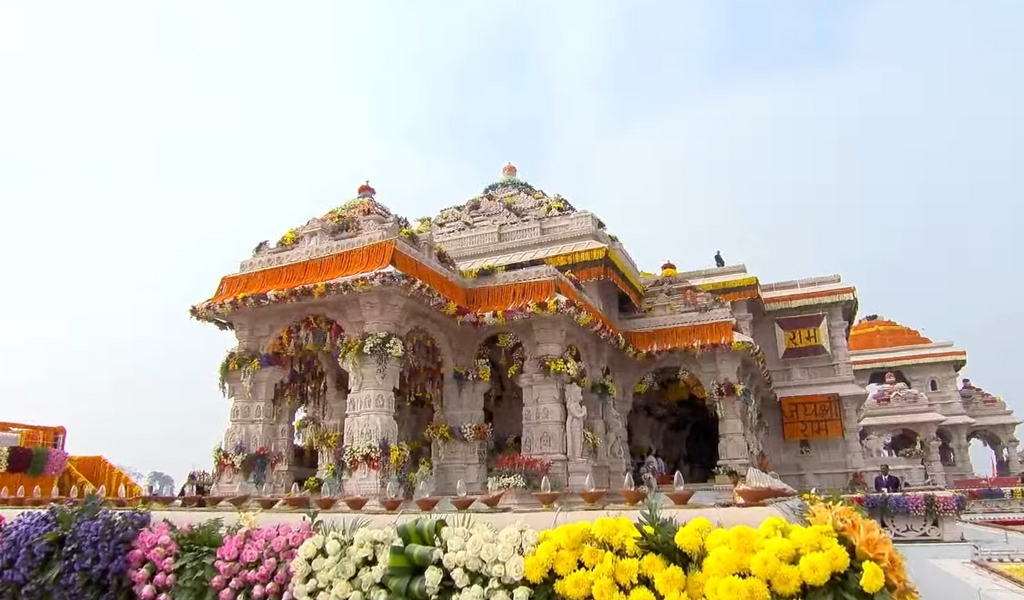The New Ram Mandir in Ayodhya, India, is a testament to the collective faith and cultural heritage of millions of Hindus worldwide. This magnificent structure, dedicated to Lord Ram, embodies architectural brilliance, artistic finesse, and religious significance.
The grandeur of the Ram Mandir is credited to the esteemed Sompura family, known for creating more than 100 temples globally. Among their notable works is the revered Somnath Temple. Led by the chief architect Chandrakant Sompura, supported by his sons Ashish and Nikhil, they are building a legacy in temple architecture that spans generations.
Also Read: The Art of Rangoli: A Tapestry of History, Tradition, and Regional Splendour
The profound spiritual significance of the Ram Mandir lies in its very foundation. It comprises sacred soil collected from 2587 regions, such as Jhansi, Bithoori, Yamunotri, Haldighati, Chittorgarh, and the Golden Temple. Every particle from these places adds to the temple’s sanctity, weaving a tapestry of spiritual unity that connects diverse regions.

Architecture:
The 3-storey Mandir, constructed in the traditional Nagara style, is crafted from pink sandstone sourced from Mirzapur and the hills of Bansi-Paharpur area in the Bharatpur district of Rajasthan.
Its construction, estimated at Rs 1,800 crore, encompasses an overall area of 71 acres, with a total width of 250 ft and a height of 161 ft. The main temple area covers 2.67 acres.
Also Read: Aipan Art: Preserving Heritage Through Patterns and Colors
The Mandir comprises 392 pillars and 44 doors comprising five halls or Mandaps: Nritya Mandap, Rang Mandap, Sabha Mandap, Prarthna Mandap, and Kirtan Mandap. Devotees enter from the east, ascending 32 stairs through the Singh Dwar.
Surrounding the main temple of Ayodhya are four temples dedicated to the Sun God, Goddess Bhagwati, Lord Ganesha, and Lord Shiva. Additionally, Sitakoop from the mythological period will be situated near the temple. Proposed temples within the premises will honour Maharishi Valmiki, Maharishi Vashishtha, Maharishi Vishwamitra, Maharishi Agastya, Nishadraj, Mata Shabari, and Rishipatni Devi Ahilya.
The Ram Mandir in Ayodhya, India, was designed by the architect Chandrakant Sompura and his team. Chandrakant Sompura, a renowned architect specializing in temple architecture, drew inspiration from traditional Indian architectural styles and scriptures to create the blueprint for the Ram Mandir. The temple’s design reflects a harmonious blend of ancient architectural principles and modern construction techniques, resulting in a majestic and awe-inspiring structure that pays homage to India’s cultural and religious heritage

.
Also Read: Unveiling the Artistry: The Rich History of Durga Puja Idols in West Bengal
Artistry:
The artistry displayed in the Ram Mandir is unparalleled, with skilled craftsmen and artisans meticulously carving intricate designs and sculptures from stone and marble. The walls and ceilings of the temple are adorned with beautiful carvings depicting scenes from the Ramayana, along with motifs symbolizing divine attributes and celestial beings. Every detail, from the delicate filigree work to the vibrant paintings adorning the walls, reflects the devotion and dedication of the artists involved in its creation.
As a poetic tribute to history, the bricks used in building the Ram Mandir are engraved with the sacred words ‘Shri Ram.’ This tradition harks back to ancient times, reminiscent of the practice during the construction of Ram Setu, where stones inscribed with ‘Shri Ram’ aided their flotation on water. The contemporary version of these bricks ensures improved strength and longevity.
Also Read: History of Ganesh Chaturthi Celebration
The physical dimensions of the Ram Mandir stretch across 360 feet in length and 235 feet in width. Its height, including the peak, rises to 161 feet. Featuring three floors and boasting 12 gates, the temple is a majestic symbol of architectural splendour.
Also Read: Lippan Art: A Unique Blend of Tradition and Craftsmanship
***
Hop over to www.rainbowsandhues.com to explore exciting offers on arts & craft supplies on our website!
Follow @rainbowsandhues on Instagram to get regular information on new products and deals!




